Caryn’s Thoughts
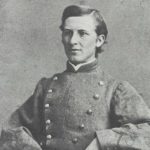
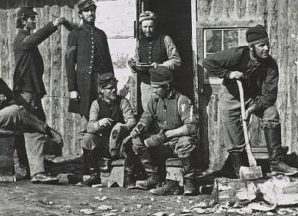 During the Civil War, the fighting was much different than these days…not just in the weapons used, but in a much bigger way. To send men out to battle in the winter was just too risky. Impassable, muddy roads and severe weather impeded active service in the wintertime. In fact, during the Civil War, the soldiers only spent a few days each year in actual combat. The rest of the time was spent getting from one battle to another, and wintering someplace because of bad weather. Even the rainy seasons caused problems, because rain brings muddy roads, and you can’t move heavy cannons on muddy roads. They get stuck. The soldiers tended to have a lot of time on their hands in the winter, and they couldn’t just go home either. In reality, disease caused more soldiers’ deaths than battle did.
During the Civil War, the fighting was much different than these days…not just in the weapons used, but in a much bigger way. To send men out to battle in the winter was just too risky. Impassable, muddy roads and severe weather impeded active service in the wintertime. In fact, during the Civil War, the soldiers only spent a few days each year in actual combat. The rest of the time was spent getting from one battle to another, and wintering someplace because of bad weather. Even the rainy seasons caused problems, because rain brings muddy roads, and you can’t move heavy cannons on muddy roads. They get stuck. The soldiers tended to have a lot of time on their hands in the winter, and they couldn’t just go home either. In reality, disease caused more soldiers’ deaths than battle did.
The soldiers sometimes kept journals of their time, which is where so much of the information we have about their time, came from. One such soldier was Elisha Hunt Rhodes. The winter months were monotonous for the soldiers. There was really nothing to do, but they needed to be kept in shape and at the ready, so the solution became days spent drilling. I’m sure that the boredom caused tempers to flair at times too, but the down time allowed the soldiers some time to bond and have a little bit of fun, as well. Nevertheless, the main objective for the winter months was to stay warm and busy, because their survival depended on it.
Rhodes was in the Army for four years, and he kept a journal for all of that time. He was a member of the 2nd Rhode Island Rhodes and fought in every battle from the First Bull Run to Appomattox. He rose from the rank of private to the rank of colonel in four years. According to Rhodes, the winter months were pretty quiet for the soldiers. They didn’t fight many battles, and so the months were spent drilling or smoking and sleeping. Some of the troops gambled and others drank or even visited the prostitutes who hung out around the camps. Believe it or not, the soldiers actually welcomed Picket Duty, which is when soldiers are posted on guard ahead of a main force. Pickets included about 40 or 50 men each. Several pickets would form a rough line in front of the main army’s camp. In case of enemy attack, the pickets usually would have time to warn the rest of the force. Picket Duty became a welcome break from the day to day monotony, because in Rhoades words, “One day is much like another at headquarters.”
Rhodes spent most of his winter months in or near Washington DC, giving him more diversions than some soldiers in the Civil War, who were in more remote locations. On one such trip into town came on February 26, 1862, he took the opportunity to hear Senator Henry Wilson from Massachusetts speak on expelling disloyal members of Congress. After listening to the speech, Rhodes and his friend Isaac Cooper attended a fair at a 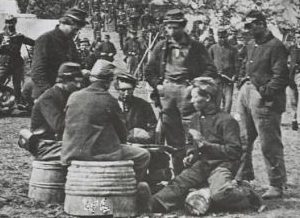
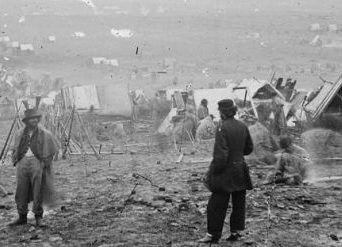 Methodist church and met two young women, who the soldiers escorted home. Like other soldiers, Rhodes welcomed the departure from winter quarters and an end to the monotony. “Our turn has come,” he wrote when his unit began moving south to Richmond, Virginia,in 1864. His winter break was over, and he would find himself back in battle again. Rhodes would survive the Civil War and after a long life, passed away on January 14, 1917 at 75.
Methodist church and met two young women, who the soldiers escorted home. Like other soldiers, Rhodes welcomed the departure from winter quarters and an end to the monotony. “Our turn has come,” he wrote when his unit began moving south to Richmond, Virginia,in 1864. His winter break was over, and he would find himself back in battle again. Rhodes would survive the Civil War and after a long life, passed away on January 14, 1917 at 75.
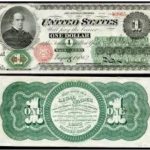 During the Civil War, money was made out of silver and gold. People would not have trusted any other form of money, but having enough silver and gold to make that money wasn’t always easy. The Northern states needed money, and they knew they had to make it, but Congress and others were concerned for the economy. If the government made money without silver or gold to back it, wouldn’t it eventually doom the economy? Most of us would call that counterfeit money, and yet our government is still doing this at times, more than we want to think about. Nevertheless, if you are part of the government, or even just someone who understands how such money can effect the economy, you might very likely be against something like the Legal Tender Act that was passed by the US Congress on this day, February 25, 1862.
During the Civil War, money was made out of silver and gold. People would not have trusted any other form of money, but having enough silver and gold to make that money wasn’t always easy. The Northern states needed money, and they knew they had to make it, but Congress and others were concerned for the economy. If the government made money without silver or gold to back it, wouldn’t it eventually doom the economy? Most of us would call that counterfeit money, and yet our government is still doing this at times, more than we want to think about. Nevertheless, if you are part of the government, or even just someone who understands how such money can effect the economy, you might very likely be against something like the Legal Tender Act that was passed by the US Congress on this day, February 25, 1862.
This was a huge step. Prior to this time, the money was real money. It needed no proof that its value was real, 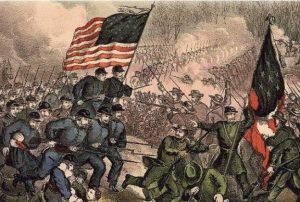 the people using it could see that for themselves. The United States didn’t have money that was basically an I.O.U. before that time. The problem was that they also had a war going on that cost a lot of money, and with people fighting the war, there were a lot less people to go out and look for gold and mine silver. It was a big problem, but the Civil War was extremely costly, and it had to be financed. The government had to face the fact that the supply of gold and silver was depleted. The Legal Tender Act was not a decision they came to lightly. They discussed every other option, including bonds. Once they settled on paper money, the Union government printed 150 million dollars in paper money…called greenbacks. The Confederate government had been printing money since the beginning of the war, which proved to be folly in the end, but I guess if the south had won, it would have gone the other way. Nevertheless, the bankers and financial experts predicted doom immediately, and many legislators worried that the money might collapse the infrastructure.
the people using it could see that for themselves. The United States didn’t have money that was basically an I.O.U. before that time. The problem was that they also had a war going on that cost a lot of money, and with people fighting the war, there were a lot less people to go out and look for gold and mine silver. It was a big problem, but the Civil War was extremely costly, and it had to be financed. The government had to face the fact that the supply of gold and silver was depleted. The Legal Tender Act was not a decision they came to lightly. They discussed every other option, including bonds. Once they settled on paper money, the Union government printed 150 million dollars in paper money…called greenbacks. The Confederate government had been printing money since the beginning of the war, which proved to be folly in the end, but I guess if the south had won, it would have gone the other way. Nevertheless, the bankers and financial experts predicted doom immediately, and many legislators worried that the money might collapse the infrastructure.
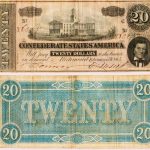
The greenbacks did not sink the economy. In fact, they worked very well. The government was able to pay its bills and, by increasing the money in circulation, the Northern economy actually improved. The greenbacks were legal tender, which meant that creditors had to accept them at face value. Life went on, but there were repercussions from the new money. In 1862, Congress was forced to pass an income tax and steep excise taxes, designed to cool the inflationary pressures created by the greenbacks. In 1863, another legal tender act was passed, and by the war’s end nearly half a billion dollars in greenbacks had been issued. The Legal Tender Act laid the foundation for the creation of a permanent currency in the decades after the Civil War.
 My grand niece, Christina Masterson has spent the last year working hard to move her life in a new direction. It’s not that her life was going in the wrong direction, but rather that she has decided what she wants to do with her life. For the last year and a half, she has worked at Macaroni Grill in Colorado Springs, and has been saving her money and making preparations to start the next step in her life. As Christina turns twenty one, many things in her life will change. Twenty one is as big a step as eighteen is. It’s one more move in the direction of full adulthood, although most eighteen year olds might argue that point. Still, when people think of someone who is eighteen, certain privileges come to mind, but more come to mind with twenty one. The obvious privilege is being able to drink alcohol legally. Christina actually had that privilege before, while living with her mother in Germany, because the legal drinking age there
My grand niece, Christina Masterson has spent the last year working hard to move her life in a new direction. It’s not that her life was going in the wrong direction, but rather that she has decided what she wants to do with her life. For the last year and a half, she has worked at Macaroni Grill in Colorado Springs, and has been saving her money and making preparations to start the next step in her life. As Christina turns twenty one, many things in her life will change. Twenty one is as big a step as eighteen is. It’s one more move in the direction of full adulthood, although most eighteen year olds might argue that point. Still, when people think of someone who is eighteen, certain privileges come to mind, but more come to mind with twenty one. The obvious privilege is being able to drink alcohol legally. Christina actually had that privilege before, while living with her mother in Germany, because the legal drinking age there  is nineteen. Nevertheless, when they moved back to the United States, Christina had to abide by the laws here. I’m sure she thought that was a bummer, but those days are behind her forever now. Just make sure you have a designated driver, Christina!!
is nineteen. Nevertheless, when they moved back to the United States, Christina had to abide by the laws here. I’m sure she thought that was a bummer, but those days are behind her forever now. Just make sure you have a designated driver, Christina!!
Christina might be old enough to drink, but that is not really where her focus is. Christina has started attending Everest College and is planning to be a dental assistant. That career might not be for everyone, but it is a necessary and important occupation, nevertheless. Dentists couldn’t really accomplish their jobs without them, and sometimes a patient only needs to see the dentist for a couple of minutes, and then the rest is up to the assistant. I’m really proud of Christina for working so hard to get  herself into a position to have a good paying career that she will enjoy doing. It is another step into the adult world for her, and I know she is excited about it. She is really carving out her own path.
herself into a position to have a good paying career that she will enjoy doing. It is another step into the adult world for her, and I know she is excited about it. She is really carving out her own path.
Probably the biggest move into the adult world is the fact that Christina has been saving her money, and she is making a big move…into her own place. Having one’s independence is always a special thing, even though her family will miss her at home, especially her brothers, but I guess they could always go spend the night sometimes…after a time for her to settle in, that is. Today is Christina’s 21st birthday. Happy birthday Christina!! You have arrived. Have a great day!! We love you!!

 Growing up, I didn’t have any brothers, and in fact, other than my dad, there weren’t any guys in the family at all until my sister, Cheryl got married, and they lived most of those early years in upstate New York. I wasn’t around him much. So, I never had a little brother until I married my husband, Bob Schulenberg, and his little 7 year old brother, Ron Schulenberg became my brother-in-law. Bob, Ron, and I got along well even during the time we were dating, and he often went places with us…a privilege he found quite acceptable. He was a good kid, and we enjoyed being around him. When I think about the fact that Ron has been my brother-in-law for almost 42 years now, I just can’t imagine life without him. I never really felt deprived of a brother, but then I never thought of Ron as a brother-in-law either. He was my little brother…from the time I first met him. I think it was a good thing Ron and I got along so well, because he and Bob have always been close. They were the only boys in a family of six kids, so banding together was kind of a necessity, and over the years they have always been able to count on
Growing up, I didn’t have any brothers, and in fact, other than my dad, there weren’t any guys in the family at all until my sister, Cheryl got married, and they lived most of those early years in upstate New York. I wasn’t around him much. So, I never had a little brother until I married my husband, Bob Schulenberg, and his little 7 year old brother, Ron Schulenberg became my brother-in-law. Bob, Ron, and I got along well even during the time we were dating, and he often went places with us…a privilege he found quite acceptable. He was a good kid, and we enjoyed being around him. When I think about the fact that Ron has been my brother-in-law for almost 42 years now, I just can’t imagine life without him. I never really felt deprived of a brother, but then I never thought of Ron as a brother-in-law either. He was my little brother…from the time I first met him. I think it was a good thing Ron and I got along so well, because he and Bob have always been close. They were the only boys in a family of six kids, so banding together was kind of a necessity, and over the years they have always been able to count on 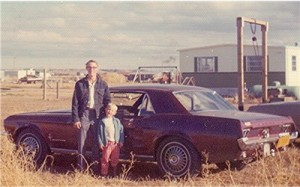 each other for any help needed, and just to be friends too. These days, their age difference doesn’t seem like much, but there are almost 14 years between them. Back then, I suppose it was odd for Bob to hang out with his little brother, but for the most part Bob enjoyed having Ron around.
each other for any help needed, and just to be friends too. These days, their age difference doesn’t seem like much, but there are almost 14 years between them. Back then, I suppose it was odd for Bob to hang out with his little brother, but for the most part Bob enjoyed having Ron around.
Some things were a little hard for Ron, and I felt kind of bad about that. Bob and his dad, Walt Schulenberg, worked so well together at fixing things up on the place, fixing the cars, and even building the garage, and because of his age, Ron always seemed to be in the way. He wanted to help too…so badly. It’s hard, in the middle of something you need to get done, to stop and teach a little 7 or 8 year old boy how he can be of some help. Of course, as time went on, Ron grew up and he became a great help to his dad and brother. I’m sure that to him, it felt like he had “finally arrived.” That was a big day for Ron. I don’t know if he ever regretted that day, because once you can help, you have fewer days to play, but then, I don’t thing Ron cared about that at all.

 I think that for Ron, the role of parent is the one he has always wanted the most…besides husband, of course. After he married his wife Rachel, Ron became dad to her children, Cassie, Riley, and Tucker. Cassie is married, and Riley lives in Powell, but Tucker is at home, and as far as he is concerned, Ron is his only daddy. He is the man who is there for him. Ron is the role model that Tucker wants and needs. They are a great little team, and I am so happy for Ron, because this has made his life complete. Today is Ron’s birthday. Happy birthday Ron!! Have a great day!! We love you!!
I think that for Ron, the role of parent is the one he has always wanted the most…besides husband, of course. After he married his wife Rachel, Ron became dad to her children, Cassie, Riley, and Tucker. Cassie is married, and Riley lives in Powell, but Tucker is at home, and as far as he is concerned, Ron is his only daddy. He is the man who is there for him. Ron is the role model that Tucker wants and needs. They are a great little team, and I am so happy for Ron, because this has made his life complete. Today is Ron’s birthday. Happy birthday Ron!! Have a great day!! We love you!!

 My sister-in-law, Debbie Cook loves all things grandchildren. Debbie has four grandchildren of her own…Weston Moore, Jala Satterwhite, Easton Moore, and Kaytlyn Griffith. The kids are involved in a variety of activities, from the little plays and programs that Kaytlyn is in, to the variety of sports the other children are in. Debbie tries not to miss out on these events, and can often be seen in the audience. It doesn’t matter what activity the kids are into this time, the grandma in Debbie can’t help but be there to watch. I can totally relate to that, because I went to everything my grandkids did too. It is simply the grandma thing to do. Those years go by so fast, so a person would be foolish to think there is always the next time.
My sister-in-law, Debbie Cook loves all things grandchildren. Debbie has four grandchildren of her own…Weston Moore, Jala Satterwhite, Easton Moore, and Kaytlyn Griffith. The kids are involved in a variety of activities, from the little plays and programs that Kaytlyn is in, to the variety of sports the other children are in. Debbie tries not to miss out on these events, and can often be seen in the audience. It doesn’t matter what activity the kids are into this time, the grandma in Debbie can’t help but be there to watch. I can totally relate to that, because I went to everything my grandkids did too. It is simply the grandma thing to do. Those years go by so fast, so a person would be foolish to think there is always the next time.
Debbie loves to quilt and cross stitch, and makes these items for the craft fairs she has sold at. It’s a big job, and sometimes one is about all she can muster, but she really finds making the beautiful things she makes to be relaxing and enjoyable. Quilting, especially is a really big job, but all the grandchildren in the family have reaped the benefit of Debbie’s ability, when she made memory quilts from their grandparents clothing after her dad, Walt Schulenberg passed away. The ability to make quilts is an amazing one, and the recipients have  something they will always treasure. I think Debbie got that ability from her grandma, Vina Hein, who made quilts over the years too…and maybe from her aunt, Esther Hein who got it from her mom too. However the ability came to her, it is a blessing to her family, and I believe she is trying to pass it along to her granddaughters, Jala and Kaytlyn.
something they will always treasure. I think Debbie got that ability from her grandma, Vina Hein, who made quilts over the years too…and maybe from her aunt, Esther Hein who got it from her mom too. However the ability came to her, it is a blessing to her family, and I believe she is trying to pass it along to her granddaughters, Jala and Kaytlyn.
Another activity that Debbie likes to share with her grandchildren is playing cards, and their favorite game right now is “Nuts.” I can’t say I have ever played that one, although, maybe I have. If I have, and I were to attempt it again, I would have to have it completely retaught to me, but Debbie’s grandkids know how and whenever their busy lives allow enough time to play, they go to their grandma’s house, and get a game going. I’m sure this activity, like all others that apply to grandchildren, will someday come to an end, for the most part, but maybe they will try to keep it alive, so that they have something they can share with the grandparents over the years.
Debbie and her husband, Lynn Cook, love to go camping, and now that both are retired, they spend a lot of time in the Big Horn Mountains. It is a way for them to unplug from everyday life. Telephone service up there is 
 spotty, so they have time to get back to nature. In the summer, they might not come down from the mountain for a couple of weeks, and then after a few days, they are ready to head back up the mountain. It is really their place of solitude. Even though they don’t live in a big town, the busy activity in town can be overwhelming sometimes, and the mountains are a great place to unwind. Of course, they love having their girls, Machelle and Susan and their families come along. Seriously, why not make it a family affair. Today is Debbie’s birthday. Happy birthday Debbie!! Have a great day!! We love you!!
spotty, so they have time to get back to nature. In the summer, they might not come down from the mountain for a couple of weeks, and then after a few days, they are ready to head back up the mountain. It is really their place of solitude. Even though they don’t live in a big town, the busy activity in town can be overwhelming sometimes, and the mountains are a great place to unwind. Of course, they love having their girls, Machelle and Susan and their families come along. Seriously, why not make it a family affair. Today is Debbie’s birthday. Happy birthday Debbie!! Have a great day!! We love you!!

 As the second anniversary of my mom’s passing drew near, my family and I have been talking more and more about the woman who was our mother. Mom was many things, as most mothers are, but one of the parts of my mom that never ceased to amaze me, was her ability to maintain a certain level of innocence, or at least what we thought was innocence. As I look back now, she was a wise woman, who managed to keep her world…quite pure and innocent. I’m not talking about her personal life, but rather our family life. There were certain lines we all knew not to cross. My sisters and I would never have cussed in front of our parents…if we wanted to live, that is, but somehow we knew that our boyfriends and husbands would be required to live up to that standard too…and they did. It was out of respect for her, my dad, and their home. That was something I always though amazing. I don’t think I even remember having to tell a boyfriend twice, not even the ones who weren’t the keeper I ended up with. It was as if they thought mom might pass out if they were to talk in an inappropriate manner. I don’t know…maybe she would have. I never dared to find out, and I’m not sorry that Mom was that way, because my sisters and I were raised to speak decently, and we have never regretted that.
As the second anniversary of my mom’s passing drew near, my family and I have been talking more and more about the woman who was our mother. Mom was many things, as most mothers are, but one of the parts of my mom that never ceased to amaze me, was her ability to maintain a certain level of innocence, or at least what we thought was innocence. As I look back now, she was a wise woman, who managed to keep her world…quite pure and innocent. I’m not talking about her personal life, but rather our family life. There were certain lines we all knew not to cross. My sisters and I would never have cussed in front of our parents…if we wanted to live, that is, but somehow we knew that our boyfriends and husbands would be required to live up to that standard too…and they did. It was out of respect for her, my dad, and their home. That was something I always though amazing. I don’t think I even remember having to tell a boyfriend twice, not even the ones who weren’t the keeper I ended up with. It was as if they thought mom might pass out if they were to talk in an inappropriate manner. I don’t know…maybe she would have. I never dared to find out, and I’m not sorry that Mom was that way, because my sisters and I were raised to speak decently, and we have never regretted that.
Another way that my mom always seemed so innocent was in her sense of humor. Mom never cared if she 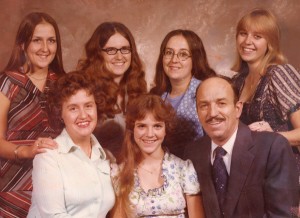 looked silly, if it could make her arguing children laugh. When you have five daughters, complete with all the drama that can be associated with it, you either get silly, or you go crazy. Well, mom was an expert at making her girls either straighten up, or laugh, usually in a very unique way. I remember Mom clearing the living room floor so that two of us could “fight it out” and once we had a good hold of each other’s hair, and were both basically pinned to the floor, the room broke out in laughter, because lets face it, it was pretty hilarious. I remember Mom making some crazy faces that we couldn’t help but laugh at, and even if we knew that Mom was mad, it was sometimes hard not to laugh about her face, but we knew that it was in our best interest not to.
looked silly, if it could make her arguing children laugh. When you have five daughters, complete with all the drama that can be associated with it, you either get silly, or you go crazy. Well, mom was an expert at making her girls either straighten up, or laugh, usually in a very unique way. I remember Mom clearing the living room floor so that two of us could “fight it out” and once we had a good hold of each other’s hair, and were both basically pinned to the floor, the room broke out in laughter, because lets face it, it was pretty hilarious. I remember Mom making some crazy faces that we couldn’t help but laugh at, and even if we knew that Mom was mad, it was sometimes hard not to laugh about her face, but we knew that it was in our best interest not to.
Life with our mom was never dull, but then again, Mom would probably tell you the same thing about life with her girls. If there was some crazy antic that we could come up with…we did. I remember ruining my brand new penny loafers because I felt the need to go trudging through the mud and the construction site at the new Kmart building. The shoes cleaned up ok, but they were now of a size to fit my younger sister, Caryl. My sister, Alena was a whiz at concocting formulas. Of course, using the “shampoo” she created was out of the question, 
 because it would probably burn your hair off. As far as terrorizing my sisters…that would have to be, yours truly. I was born with strong fingernails…well daggers actually, and I did not hesitate to use them. Sometimes I wonder how I survived childhood, because if anyone drove our mom crazy, it was me. I’m sure that my wedding day was cause for celebration on many levels. Just thinking about what I put my mom through…well, I can’t decide whether to laugh or cry. I think that is how Mom had to have felt. It really was get silly, or go crazy in our house.
because it would probably burn your hair off. As far as terrorizing my sisters…that would have to be, yours truly. I was born with strong fingernails…well daggers actually, and I did not hesitate to use them. Sometimes I wonder how I survived childhood, because if anyone drove our mom crazy, it was me. I’m sure that my wedding day was cause for celebration on many levels. Just thinking about what I put my mom through…well, I can’t decide whether to laugh or cry. I think that is how Mom had to have felt. It really was get silly, or go crazy in our house.
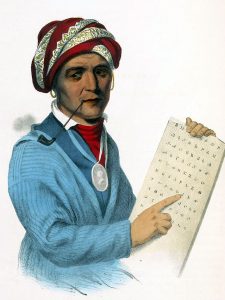 The Indian tribes in the United States had a spoken language, but in the early years they had no real need for a written language, other than hieroglyphics. At some point, a young Cherokee man named Sequoyah noticed something about the men in Andrew Jackson’s platoon, while he and some other Cherokee men were volunteering in the fight against the British in the War of 1812. In dealing with the Anglo soldiers and settlers, Sequoyah became intrigued by their “talking leaves” or printed books. Sequoyah realized that somehow the “talking leaves” recorded human speech. In a brilliant leap of logic, Sequoyah comprehended the basic nature of symbolic representation of sounds and in 1809 he began working on a similar system for the Cherokee language. Little did Sequoyah know that his work would change things, and in fact, change life for the Cherokee people. Still, it was not without it’s downside. Sequoyah was ridiculed and misunderstood by most of the Cherokee. Nevertheless, he made slow progress until he came up with the idea of representing each syllable in the language with a separate written character. Finally, he perfected his syllabary of 86 characters, a system that could be mastered in less than week. After obtaining the official endorsement of the Cherokee leadership, Sequoyah’s invention was soon adopted throughout the Cherokee nation.
The Indian tribes in the United States had a spoken language, but in the early years they had no real need for a written language, other than hieroglyphics. At some point, a young Cherokee man named Sequoyah noticed something about the men in Andrew Jackson’s platoon, while he and some other Cherokee men were volunteering in the fight against the British in the War of 1812. In dealing with the Anglo soldiers and settlers, Sequoyah became intrigued by their “talking leaves” or printed books. Sequoyah realized that somehow the “talking leaves” recorded human speech. In a brilliant leap of logic, Sequoyah comprehended the basic nature of symbolic representation of sounds and in 1809 he began working on a similar system for the Cherokee language. Little did Sequoyah know that his work would change things, and in fact, change life for the Cherokee people. Still, it was not without it’s downside. Sequoyah was ridiculed and misunderstood by most of the Cherokee. Nevertheless, he made slow progress until he came up with the idea of representing each syllable in the language with a separate written character. Finally, he perfected his syllabary of 86 characters, a system that could be mastered in less than week. After obtaining the official endorsement of the Cherokee leadership, Sequoyah’s invention was soon adopted throughout the Cherokee nation.
Finally, it was time for the next step. The General Council of the Cherokee Nation decided to purchase a  printing press. Their goal was to produce a newspaper in the Cherokee language. When the Cherokee-language printing press arrived on this day, February 21, 1828, the lead type was based on Sequoyah’s syllabary. Within months, the first Indian language newspaper in history appeared in New Echota, Georgia. It was called the Cherokee Phoenix. The Cherokee tribe was one of what the Americans called the “five civilized tribes” and they were native to the American Southeast. The Cherokee had long ago decided to embrace the United States’ program of “civilizing” Indians in the years after the Revolutionary War. In the minds of Americans, Sequoyah’s syllabary showed the Cherokee desire to fit into their dominant Anglo world. The Cherokee used their new press to print a bilingual version of the republican constitution. They also took many other steps to assimilate Anglo culture and practice while still preserving some aspects of their traditional language and beliefs. The press worked well, but would have been useless had it not been for the extraordinary work of Sequoyah.
printing press. Their goal was to produce a newspaper in the Cherokee language. When the Cherokee-language printing press arrived on this day, February 21, 1828, the lead type was based on Sequoyah’s syllabary. Within months, the first Indian language newspaper in history appeared in New Echota, Georgia. It was called the Cherokee Phoenix. The Cherokee tribe was one of what the Americans called the “five civilized tribes” and they were native to the American Southeast. The Cherokee had long ago decided to embrace the United States’ program of “civilizing” Indians in the years after the Revolutionary War. In the minds of Americans, Sequoyah’s syllabary showed the Cherokee desire to fit into their dominant Anglo world. The Cherokee used their new press to print a bilingual version of the republican constitution. They also took many other steps to assimilate Anglo culture and practice while still preserving some aspects of their traditional language and beliefs. The press worked well, but would have been useless had it not been for the extraordinary work of Sequoyah.
Sequoyah was born about 1770 in Tuskegee, Cherokee Nation, near present day Knoxville, Tennessee. He died 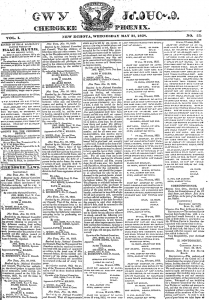 August 1843 at about 72 or 73, in San Fernando, Tamaulipas, Mexico. His name in English is George Gist or George Guess, which I find to be…well, crazy. Why was it necessary to butcher his name. Sequoyah was a Cherokee silversmith by trade, but his biggest claim to fame was the creation of written Cherokee. In 1821, when he completed his independent creation of a Cherokee syllabary, he successfully made reading and writing in Cherokee possible. This was one of the very few times in recorded history that a member of a pre-literate people created an original, effective writing system. After seeing its worth, the people of the Cherokee Nation rapidly began to use his syllabary and officially adopted it in 1825. Their literacy rate quickly surpassed that of surrounding European-American settlers. In recognition of his service, the Cherokee Nation voted Sequoyah an annual allowance in 1841. He died two years later on a trip to San Fernando, seeking Cherokee to return to Oklahoma with him. The giant California redwood tree, Sequoia, was named after him.
August 1843 at about 72 or 73, in San Fernando, Tamaulipas, Mexico. His name in English is George Gist or George Guess, which I find to be…well, crazy. Why was it necessary to butcher his name. Sequoyah was a Cherokee silversmith by trade, but his biggest claim to fame was the creation of written Cherokee. In 1821, when he completed his independent creation of a Cherokee syllabary, he successfully made reading and writing in Cherokee possible. This was one of the very few times in recorded history that a member of a pre-literate people created an original, effective writing system. After seeing its worth, the people of the Cherokee Nation rapidly began to use his syllabary and officially adopted it in 1825. Their literacy rate quickly surpassed that of surrounding European-American settlers. In recognition of his service, the Cherokee Nation voted Sequoyah an annual allowance in 1841. He died two years later on a trip to San Fernando, seeking Cherokee to return to Oklahoma with him. The giant California redwood tree, Sequoia, was named after him.
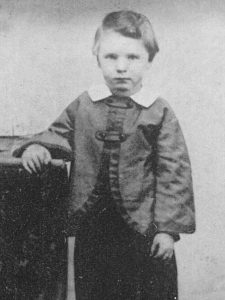 When we think of the White House, we seldom think of death. Oh, there have been presidents who were assassinated, or died while in office, but mostly not in the White House. It is too well guarded, and an ill president usually was taken to a hospital. Nevertheless, death has visited the White House, and the case I am referring to was not a president, but rather his son. Abraham Lincoln is my 7th cousin thrice removed, making his children, my 7th cousins 4 times removed. Lincoln married Mary Todd on November 4, 1842, in Springfield, Illinois. They were the parents of four sons Robert Todd Lincoln was born in 1843 and Edward Baker “Eddie” Lincoln in 1846. Edward died on February 1, 1850, in Springfield, probably of Tuberculosis. William Wallace “Willie” Lincoln was born on December 21, 1850, and died of a Typhoid Fever on February 20, 1862. The Lincolns’ fourth son, Thomas “Tad” Lincoln, was born on April 4, 1853, and died of heart failure at the age of 18 on July 16, 1871. While three of the four boys died in childhood, only one, Willie passed away in the White House.
When we think of the White House, we seldom think of death. Oh, there have been presidents who were assassinated, or died while in office, but mostly not in the White House. It is too well guarded, and an ill president usually was taken to a hospital. Nevertheless, death has visited the White House, and the case I am referring to was not a president, but rather his son. Abraham Lincoln is my 7th cousin thrice removed, making his children, my 7th cousins 4 times removed. Lincoln married Mary Todd on November 4, 1842, in Springfield, Illinois. They were the parents of four sons Robert Todd Lincoln was born in 1843 and Edward Baker “Eddie” Lincoln in 1846. Edward died on February 1, 1850, in Springfield, probably of Tuberculosis. William Wallace “Willie” Lincoln was born on December 21, 1850, and died of a Typhoid Fever on February 20, 1862. The Lincolns’ fourth son, Thomas “Tad” Lincoln, was born on April 4, 1853, and died of heart failure at the age of 18 on July 16, 1871. While three of the four boys died in childhood, only one, Willie passed away in the White House.
Disease was a scary thing in those days, because many serious diseases, which we have cures for now, were a death sentence in those days. Little Willie Lincoln had contracted Typhoid Fever. Typhoid fever, also known simply as typhoid, is a bacterial infection due to Salmonella Typhi that causes symptoms which may vary from mild to severe and usually begin six to thirty days after exposure. The disease was all over Washington DC, and 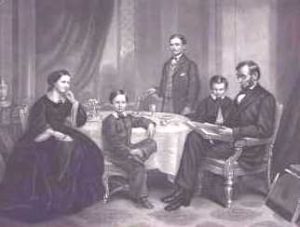 even the White House was not safe from it’s deathly grip. In fact, Willie was not the only one to have it. His brother, Tad was in bed just down the hall, with the same illness. Tad would survive, but I have to wonder if his heart was not severely weakened by the disease, because he passed away just nine years later of heart failure. On February 20, 1862, little 11 year old Willie succumbed to the Typhoid Fever at 5:00pm. His parents were with him, and Abraham Lincoln said, “My poor boy, he was too good for this earth. God has called him home. I know that he is much better off in heaven, but then we loved him so. It is hard, hard to have him die!” Mary watched him bury his head in his hands, “his tall frame convulsed with emotion.” At the foot of the bed she stood “in silent, awe-stricken wonder,” marveling that so rugged a man could be so moved. “I shall never forget those solemn moments — genius and greatness weeping over love’s idol lost.” President Lincoln then walked down the hall to his secretary’s office. He startled the half-dozing secretary with the news: “Well, Nicolay, my boy is gone — he is actually gone!” John Nicolay recalled seeing his boss burst into tears before entering his own office. I think I have to agree with Mary. When we think of Abraham Lincoln, we think of a strong man, but if we think about it, he also had a softer side, and he loved children.
even the White House was not safe from it’s deathly grip. In fact, Willie was not the only one to have it. His brother, Tad was in bed just down the hall, with the same illness. Tad would survive, but I have to wonder if his heart was not severely weakened by the disease, because he passed away just nine years later of heart failure. On February 20, 1862, little 11 year old Willie succumbed to the Typhoid Fever at 5:00pm. His parents were with him, and Abraham Lincoln said, “My poor boy, he was too good for this earth. God has called him home. I know that he is much better off in heaven, but then we loved him so. It is hard, hard to have him die!” Mary watched him bury his head in his hands, “his tall frame convulsed with emotion.” At the foot of the bed she stood “in silent, awe-stricken wonder,” marveling that so rugged a man could be so moved. “I shall never forget those solemn moments — genius and greatness weeping over love’s idol lost.” President Lincoln then walked down the hall to his secretary’s office. He startled the half-dozing secretary with the news: “Well, Nicolay, my boy is gone — he is actually gone!” John Nicolay recalled seeing his boss burst into tears before entering his own office. I think I have to agree with Mary. When we think of Abraham Lincoln, we think of a strong man, but if we think about it, he also had a softer side, and he loved children.
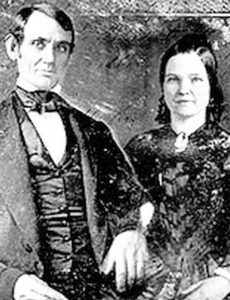 Willie Lincoln was a favorite around the White House. In the words of a government official’s wife, “The White House is sad and still, for its joy and light have fled with little Willie. He was a very bright child, remarkably precocious for his age, and had endeared himself to every one who knew him.” Mary Lincoln’s cousin said he was “noble, beautiful…a counterpart of his father, save that he was handsome.” Mary herself called him the “idolized child, of the household.” It’s somewhat strange to think that such a large household as the White House, with all of it’s staff who work there, could be so changed by the death of a child, but Willie Lincoln was not an ordinary child. Had he been, he might not have come to the attention of everyone in the White House. Most of us know who the first children are but the White House staff knew Willie Lincoln and dearly loved him. As dates in history go, while this little boy was not an important man is the way we think of that today, he had a impact that went far beyond his short time on this earth, and his dying day was one that saddened a nation.
Willie Lincoln was a favorite around the White House. In the words of a government official’s wife, “The White House is sad and still, for its joy and light have fled with little Willie. He was a very bright child, remarkably precocious for his age, and had endeared himself to every one who knew him.” Mary Lincoln’s cousin said he was “noble, beautiful…a counterpart of his father, save that he was handsome.” Mary herself called him the “idolized child, of the household.” It’s somewhat strange to think that such a large household as the White House, with all of it’s staff who work there, could be so changed by the death of a child, but Willie Lincoln was not an ordinary child. Had he been, he might not have come to the attention of everyone in the White House. Most of us know who the first children are but the White House staff knew Willie Lincoln and dearly loved him. As dates in history go, while this little boy was not an important man is the way we think of that today, he had a impact that went far beyond his short time on this earth, and his dying day was one that saddened a nation.
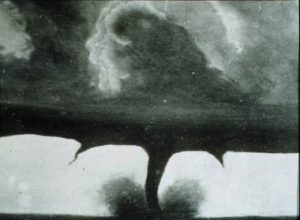 These days, tornado watches and warnings are a normal part of life. They may not happen every day, but when they do sound, we know what to do to stay as safe as possible. The warnings don’t always mean that there are zero deaths from a tornado, but they do help. Unfortunately, the tornado warning sirens, Doppler radar, and television warnings did not exist in 1884. In those days, people had to rely on the skies to tell them what was coming, and as most of us know, that is not always an easy task. In fact, it has taken hundreds of years to even begin to come close to perfecting a system whereby the public could be warned of approaching severe weather, and even then, it hasn’t eliminated the deaths that can occur from these storms.
These days, tornado watches and warnings are a normal part of life. They may not happen every day, but when they do sound, we know what to do to stay as safe as possible. The warnings don’t always mean that there are zero deaths from a tornado, but they do help. Unfortunately, the tornado warning sirens, Doppler radar, and television warnings did not exist in 1884. In those days, people had to rely on the skies to tell them what was coming, and as most of us know, that is not always an easy task. In fact, it has taken hundreds of years to even begin to come close to perfecting a system whereby the public could be warned of approaching severe weather, and even then, it hasn’t eliminated the deaths that can occur from these storms.
One of the largest and most widespread tornado outbreaks in American history happened at a time when warnings did not exist. It happened on this day February 19, 1884, and into February 20, 1884. The precise number of tornadoes, as well as fatalities incurred during the outbreak remains unknown. The outbreak was nicknamed “Enigma outbreak” and is well known by that name. Research of newspaper reports and governmental studies published in the aftermath reveals tornadoes, or in reality, long-track tornado families, struck Alabama, 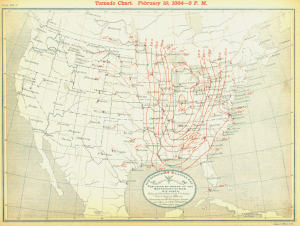 Georgia, Illinois, Indiana, Kentucky, Mississippi, North Carolina, South Carolina, Tennessee and Virginia. It is estimated that at least 50 tornadoes struck those states that day. Some events that had been counted as tornadoes in initial studies, such as those by John Park Finley, were actually downbursts, especially in northern and northeastern portions of the outbreak. Nevertheless, the damage done was nothing to be overlooked.
Georgia, Illinois, Indiana, Kentucky, Mississippi, North Carolina, South Carolina, Tennessee and Virginia. It is estimated that at least 50 tornadoes struck those states that day. Some events that had been counted as tornadoes in initial studies, such as those by John Park Finley, were actually downbursts, especially in northern and northeastern portions of the outbreak. Nevertheless, the damage done was nothing to be overlooked.
The majority of the reported tornadic activity was seen across Alabama, Georgia, South Carolina and North Carolina, which were all struck severely by multiple waves of tornado families. In the Southeast, the outbreak began during the late morning in Mississippi, preceded by severe thunderstorms in Louisiana. Shortly thereafter, the outbreak widened and intensified, progressing from Alabama to Virginia between noon and midnight. In addition to the outbreak, wind damage, flash floods, with homes swept away by water in Louisville, Kentucky, New Albany, Indiana, and Jeffersonville, Indiana and other towns along the Ohio River, and Derecho-like effects in the Ohio Valley were also reported in published accounts of the outbreak. In case you didn’t know, a Derecho is a widespread, long-lived, straight-line wind storm that is 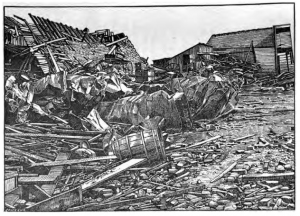 associated with a land-based, fast-moving group of severe thunderstorms. In addition to that, blizzard conditions occurred in the eastern Midwest, as a part of this storm series. According to an article appearing in the Statesville, North Carolina Landmark three days later, the damage tally in Georgia alone was estimated to be $1 million, in 1884 dollars. Today, the damage would have been approximately $23,660,667. That is an astounding figure, and that is just the property damage numbers. Loss of life simply cannot be measured in money. In fact, the greatest mystery surrounding this horrific event is the possibility that, in all likelihood, as many as 1,200 people lost their lives that day at the hands of the 1884 Enigma Tornado Outbreak.
associated with a land-based, fast-moving group of severe thunderstorms. In addition to that, blizzard conditions occurred in the eastern Midwest, as a part of this storm series. According to an article appearing in the Statesville, North Carolina Landmark three days later, the damage tally in Georgia alone was estimated to be $1 million, in 1884 dollars. Today, the damage would have been approximately $23,660,667. That is an astounding figure, and that is just the property damage numbers. Loss of life simply cannot be measured in money. In fact, the greatest mystery surrounding this horrific event is the possibility that, in all likelihood, as many as 1,200 people lost their lives that day at the hands of the 1884 Enigma Tornado Outbreak.

 As their youngest child becomes a teenager, parents suddenly have these bittersweet moments. They are proud of the young person their baby has grown into, but they know they will forever miss the baby they once were. That is the very feeling expressed by my niece, Machelle Moore, as she prepares to celebrate her youngest son, Easton Moore’s birthday today. Easton was a cute little boy, and his big brother, Weston Moore was so excited to have a brother. I remember Easton as a smiley little guy with things to do, places to go, and people to see…even if he never left to house. He was busy. No sitting still for him.
As their youngest child becomes a teenager, parents suddenly have these bittersweet moments. They are proud of the young person their baby has grown into, but they know they will forever miss the baby they once were. That is the very feeling expressed by my niece, Machelle Moore, as she prepares to celebrate her youngest son, Easton Moore’s birthday today. Easton was a cute little boy, and his big brother, Weston Moore was so excited to have a brother. I remember Easton as a smiley little guy with things to do, places to go, and people to see…even if he never left to house. He was busy. No sitting still for him.
Easton, like most elementary school kids these days, got into Lego Robotics, and really enjoyed that, as did his family. His mom, Machelle Moore tells me that phase is winding down now, and it makes her feel sad, because her little boy is growing up. Yesterday, Easton told her, “Today is my birthday eve.” I’m sure her heart jumped a little bit, because her youngest boy was almost a teenager. The time had flown by so fast, and all she could  think of is, “Where is the brake pedal?” I knew just how she feels. Our time with our little ones is just a drop in the bucket of life, and all too soon it is behind us. Nevertheless, Easton made her feel better when he said, “Don’t worry Mom, I am still gonna be your sweet boy when I am 13.” That little jump in her heart must have turned into a lump in her throat, because it was tough holding back the tears.
think of is, “Where is the brake pedal?” I knew just how she feels. Our time with our little ones is just a drop in the bucket of life, and all too soon it is behind us. Nevertheless, Easton made her feel better when he said, “Don’t worry Mom, I am still gonna be your sweet boy when I am 13.” That little jump in her heart must have turned into a lump in her throat, because it was tough holding back the tears.
Of course, thirteen isn’t twenty five, and Easton still has a few “kid years” left to enjoy. These days he is heavily into Nerf guns, and even has a Nerf crossbow. His dad, Steve Moore loves guns, and while Easton’s guns are Nerf guns, it is still a passion they can share. They have even re-worked the Nerf guns, so they will get more distance. Guns are a passion that Easton is not likely to outgrow…although the gun type will progress into real guns at some point. Still, I can see them “shooting” each other with Nerf guns far into the future, because lets face it, men never really grow up. While Easton’s early years focused a lot on his mom as little ones often do, he latter years will likely follow along the lines of activities with his dad. Not that he won’t always cherish his mom, because he will, but boys just tend to do more things with their dads as they get older. However, Machelle likes doing the things Steve likes, so I’m sure she will be along for those activities too.


Easton is growing up, and that’s for sure, but as I’ve said, there are still a few years of boyhood left, and he still likes doing the goofy things that most boys do. Things that might gross girls out, are the coolest things to a boy. Most kids like bubble gum and blowing bubbles is the biggest part of the fun, but it takes the little kid in a person to want to film the process, and take special notice of the part where the bubble meets the face. Yes, the little boy is Easton is alive and well, and as long as he enjoys doing the goofy things, that little boy always will be. Today is Easton’s 13th birthday. Happy birthday Easton!! Have a great day, and don’t grow up too fast!! We love you!!

